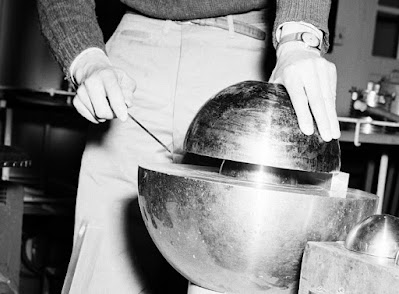During the final days of World War II, the United States developed several plutonium cores intended for nuclear bombs. One of these was later known as The Demon Core—a 6.2 kg sphere of plutonium-239 that was originally planned for use in a third atomic bombing on Japan. However, after Japan’s surrender on August 15, 1945, the core was repurposed for scientific experiments, leading to two fatal radiation accidents.
A Third Bomb That Was Never Dropped
The Demon Core was meant to be part of a third atomic bomb, following Little Boy (dropped on Hiroshima) and Fat Man (dropped on Nagasaki). However, after Japan surrendered, the core was no longer needed as a weapon. Instead, scientists at the Los Alamos Laboratory in the U.S. used it for criticality experiments—tests to understand the behavior of nuclear materials.
The First Fatal Incident (August 21, 1945)
Physicist Harry Daghlian was conducting an experiment to determine the core’s critical mass. He accidentally dropped a tungsten carbide brick onto the core, momentarily causing a critical reaction that emitted a burst of radiation. Daghlian quickly removed the brick, but he had already absorbed a lethal dose of radiation. He died 25 days later from acute radiation poisoning.
The Second Fatal Incident (May 21, 1946)
Physicist Louis Slotin was performing another experiment, known as the “tickling the dragon’s tail” test, where he manually lowered a beryllium dome over the core to measure reactivity. He was using a screwdriver to keep the dome slightly open, but it slipped, causing the dome to fully enclose the core and trigger a critical reaction. A flash of blue light and a wave of heat filled the room. Slotin immediately removed the dome, stopping the reaction, but he had already received a fatal radiation dose. He died nine days later.
The End of the Demon Core
After these two deadly accidents, the U.S. government decided to stop manual criticality experiments. The Demon Core was eventually melted down and its material was used in other nuclear tests, ensuring it would never again pose a direct risk to human life.
These incidents remain among the most infamous examples of the dangers of nuclear research. The lessons learned from The Demon Core contributed to stricter safety protocols in handling radioactive materials.










No comments:
Post a Comment